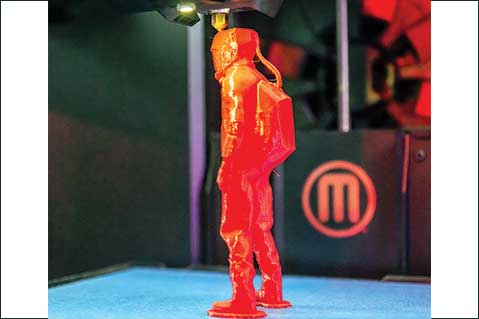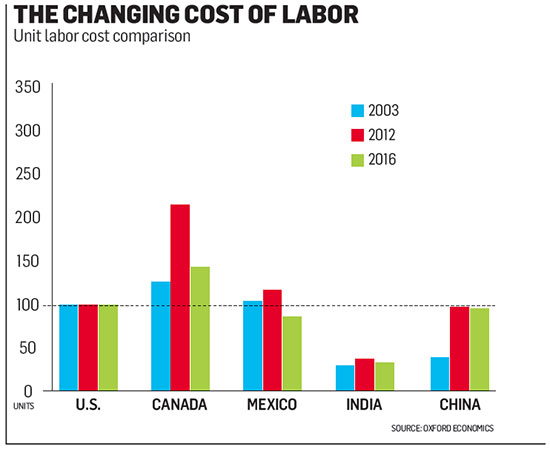Awards April 04, 2017
The Future of Manufacturing in the Promo Industry
The first in a series of reports forecasting trends and their effect on the promo industry.
Deep in the heart of China’s Guangdong province, the robot revolution is well underway. About two years ago, the Changying Precision Technology Company – known for making cellphone parts – replaced most of its 650 human workers with mechanical arms, automated belts and unmanned transport vehicles. Supervised by a skeleton crew of staffers, the machines have since increased productivity threefold, while cutting the plant’s defect rate from 25% to just 5%.

The factory is now just one of a growing number of robot-driven facilities across Asia – a movement designed to counter the heightened cost of manual labor in the region. It’s likely the shift will only accelerate over time – and not just in China. An oft-cited report from Boston Consulting Group estimates “that, because of wider robotics use, the total cost of manufacturing labor in 2025 could be 16% lower, on average, in the world’s 25 largest goods-exporting economies than they would be otherwise.”
>>Don't miss! The Future of 3-D Printing in the Promo Products Industry
While the robots-are-taking-over story grabs the headlines, it’s only part of the compelling tapestry that is the future of manufacturing. Other trends are also in play, which will no doubt spur changes in the promo products industry and beyond.
Will China’s Dominance Persist?
The biggest change looming on the horizon for the promo industry is a potential shift in factory locations. Right now, China is the hotbed of manufacturing due to comparatively lower labor costs combined with efficiency and ability – a combination that can’t be matched in North America. But a big question lingers: With today’s political environment and the growing need for consumers to get their products faster and faster, will more manufacturing return to the U.S.? Clearly there would be benefits to such a shift.
“Here, I can control my lead times,” says Alex Morin, executive vice president of sales and marketing at Debco Solutions (asi/48880). “I can stock things. I can create my technology to be able to get things out faster. I can improve order processing and capacity in the print shop and how the warehouse pulls product. I’m in complete control when it comes to domestic. When it comes to the factories overseas, that’s a completely different question. There are all sorts of variables that are out of our control.”
Politically, too, it may get harder to keep producing things overseas. The Trump administration has proposed border taxes and tariffs, among other regulations, on products made outside the U.S. If those tariffs were to reach 30%, would that be enough to dampen China’s production dominance?
“This idea of border tax and all that sounds well and good to a lot of people,” says Robert Fiveash, president of Brand Fuel (asi/145025), “but when it delays or dampens the enthusiasm for manufacturers to actually make big investments in the U.S. and factory production because of the uncertainty, it has the exact opposite effect.”
Yuhling Lu, vice president of Ariel Premium Supply (asi/36730), thinks some production will return to the U.S., but it will only be a marginal amount, and the majority of manufacturing will remain overseas.
“It will be hard for another lower labor cost location or country to pick up the manufacturing work from China in the near future, since their infrastructure has not been well established to support the manufacturing work,” Lu says.
Morin and Fiveash agree, both noting that even though labor prices are on the rise in China making it more expensive to manufacture there, the U.S. just isn’t ready for all manufacturing to return. This country’s labor force is much more expensive, and frankly, the U.S. doesn’t have the manufacturing capacity anymore, Fiveash says.
The best option moving forward, according to Morin, is to learn to work smarter with factories overseas. He suggests using data forecasting to predict what’s going to trend among distributor orders, and then creating partnerships with factories to stock items instead of producing them on demand. That way, even though production remains overseas, working through rush orders can be much easier.
Lu concurs, believing that production time, as well as the wait for raw materials, can be sped up by providing forecasting information in advance to factories.
Robot Revolution
It’s one of an employee’s worst nightmares: to one day be completely replaced by a robot designed to do her job. And as we grow more technologically advanced as a culture, the possibility is very real. Both Fiveash and Morin believe that robots will completely replace people in certain positions at manufacturers – it’s the wave of the future for automation to become more prevalent.
“We are going to have to find a way to train folks that previously held those types of positions to be useful cogs in the wheel when those changes do come,” Fiveash says. But both Joanne Pransky, a robot psychiatrist who helps prepare people physically and emotionally for the rapidly changing rate of technology, and Rich Walker, the managing director of robotics company Shadow Robot, think robots will never completely replace people. Instead, they’ll just replace tasks and functions. Ideally, robots will take over repetitive tasks that people are currently doing – like wiring earbuds or shaping plastic promo items – allowing workers to find more skilled positions within a company, possibly bringing about the need for more staff in general.
Walker cited the Volkswagen factory in Germany as an example. When the company brought in robots to take over certain tasks, efficiency increased, leading to the production of more cars, forcing the company to hire more staff to handle the influx of product.
“We have to really understand robotics and automation and not necessarily what we read in headlines or what we hear,” Pransky says. “Automation has always increased productivity in general. It’s created more jobs than it’s destroyed. Robots cannot replace a whole human. It could perhaps just put that human at a better, more fulfilling job.” According to Walker, adding robots to the manufacturing process might even be more beneficial for product safety and compliance. He notes that some robots are intelligent – but not in the iRobot, all-consuming way you might think. It’s actually much simpler. They have a spatial sensing system allowing for quality assurance checks to be done as the task itself is completed. “So for example, a vision system used to control grasping can confirm that you put the part in the right place at the end of the process,” he says.

Morphing Materials
Both Lu and Fiveash note that there’s a big disposability problem in the promotional products industry today. Although most manufacturers hope their items are used continuously, the truth is that products are often made from cheap plastic, or materials that tend to break, and those products end up in the garbage.
“It has been a challenge for us to find promotional products made of material that is affordable as well as environmentally friendly,” Lu says. “The future will bring sustainable manufacturing, environmentally friendly material or recycled material, and products that can be used for a long time.”
Fiveash believes that as a distributor, it’s partially his responsibility to force the shift to more eco-friendly products and materials. “If we as an industry can emphasize the longevity of the promotional product and the fact that we’re doing everything we can to keep it out of the landfill, I think we’re going to be able to put pressure on manufacturers to use materials that will last longer,” he says. “The longer this item stays in use, the more eyes are going to be on it. I think sustainable items are appealing to more and more people.”
Morin thinks even past that point, the materials of the future will come down to a consumer’s personal choice – based on whatever futuristic resin material is being piped into our home for us to create with. “If you have a metallic resin or a plastic resin in your house and if you were to say, ‘I really want this bottle to drink water from,’ you’re the one who can choose how it’s made,” he says. “A composite of both materials, one in plastic, one in metal – you’ll be able to select what you want. When we say what types of materials will be used, it’ll be your choice.”
Coming Factories
Like the shift to more sustainable materials, manufacturers predict that the eco-friendly trend will find its way into the factories of the future as well. Morin says that China is seeing a lot of issues in factory production due to pollution. He thinks the government there will soon mandate the factories to work in a more eco-friendly manner – and with that will come a snowball of new emphasis on safety and compliance reaching all the way through the supply chain.
“The pressure is being put on domestically, and when they put pressure on the supply chain to make sure products are compliant for their stakeholders, that pressure goes all the way through the supply channel to Asia,” Morin says. “When that pressure is applied, it makes sure policy changes are happening regularly and routinely and will continue to happen overseas.”
Lu thinks that as stricter compliance and safety regulations are introduced to match our changing technology, it could lead to big changes – so big that some manufacturers may need to completely tear down their factories and build new ones from scratch.
Regardless of what happens and what the future will bring, changes always bring about new opportunities – and for Morin, that’s the best part of what’s to come. “There’s so much happening these days,” he says. “Nothing changes overnight. These are all gradual changes. But possibilities do change overnight, and that’s what’s cool – taking a look at those possibilities and forecasting them, and setting ourselves up for success in the future.”
– jennifer@jenniferbillock.com
